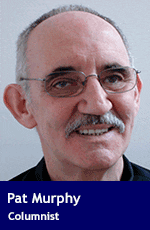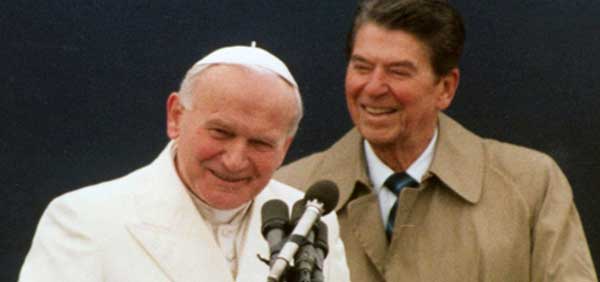 In a recent column, I wrote about Poland’s 20th century tragedy, culminating in the “betrayal” to Josef Stalin at the February 1945 Yalta Conference. So it’s appropriate to finish the story by writing about Poland’s resurrection.
In a recent column, I wrote about Poland’s 20th century tragedy, culminating in the “betrayal” to Josef Stalin at the February 1945 Yalta Conference. So it’s appropriate to finish the story by writing about Poland’s resurrection.
While the Poles were the main players in this resurrection, they did have external help. Changing circumstances in the Soviet Union were certainly a critical element. And another was the unlikely collaboration of two men – the Polish pope in the Vatican and the 40th president of the United States.
In an interesting irony, that president – Ronald Reagan – was a lifelong admirer of Franklin D. Roosevelt, the earlier president who’d been one of Yalta’s architects. But although Reagan’s affection for Roosevelt never waned, his view of Yalta was another matter entirely. Its apparent legitimization of Soviet domination in Eastern Europe was several bridges too far.
Commentators often note certain life trajectory similarities between Reagan and Pope John Paul II. Neither man would have been considered an obvious choice for the position he came to occupy. And both were targets of attempted assassination.
But perhaps the most important thing they had in common was their rejection of the reorganization of Europe set out at Yalta. In this, they were genuine rebels against established orthodoxy.
And it’s very easy to forget how absolutely dominant that orthodoxy was. The Yalta Conference, the subsequent division of Europe and the permanence of communism were considered immutable. All the best people said so.
For instance, the New York Times deployed the full force of conventional wisdom in its editorial response to John Paul’s 1979 visit to Poland: “As much as the visit of Pope John Paul II to Poland must reinvigorate and re-inspire the Roman Catholic Church in Poland, it does not threaten the political order of the nation or of Eastern Europe.”
Reagan’s public ruminations about the aberrational and transient nature of communism – whether delivered at Notre Dame in May 1981 or Westminster in June 1982 – were dismissed even more derisively. If he wasn’t a joke, he was “bordering on delusional.” No serious person could possibly think that way.
But that was what he thought. And he was very serious.
In a real sense, the papal-presidential collaboration began with John Paul’s galvanizing 1979 Polish pilgrimage. Greeted by enormous and emotional crowds, the pope exhorted people to “Be not afraid.” And speaking directly to Poland’s situation, he said: “There can be no just Europe without the independence of Poland marked on its map.”
Still a private citizen, albeit planning to run for president in 1980, Reagan noticed. The papal visit became a topic for his syndicated radio commentaries and the fervent Catholicism of the pope’s audiences left a deep mark. As he subsequently put it in a private letter to a friend, “I have had a feeling … that religion might very well turn out to be the Soviets’ Achilles heel.”
Noting the “unusually large number of Catholic advisers in foreign policy positions,” the English political commentator John O’Sullivan has described Reagan as “culturally a Catholic.”
That’s probably a stretch. However, it’s fair to say that Reagan was very comfortable with a certain kind of 20th century Catholic prelate: successful men like Philadelphia’s Cardinal John Krol, who combined an undiluted patriotism with a humble family background. In effect, men just like Reagan.
Carl Bernstein – of Woodward-Bernstein Watergate fame – ignited a firestorm by using the term “Holy Alliance” to describe the papal-presidential collaboration. But strip away the objections to journalistic overkill and you’re left with the fact that there really was a substantive partnership.
From the beginning of Reagan’s presidency, a special Polish update was included in his daily intelligence briefing. There was also intensive back-and-forth communication with the Vatican, invariably conducted outside normal State Department channels.
The pace picked up following the December 1981 imposition of martial law in Poland. The objective was to keep the labour union Solidarity alive.
The Americans brought money and military intelligence to the table. The Vatican contributed political intelligence and its internal Polish church network. Between them, Solidarity was kept clandestinely supplied with communication essentials like fax machines, photocopiers, transmitters, shortwave radios and so forth.
It worked.
Former U.S. president Barack Obama is fond of referring to the ultimately benign nature of “the arc of the moral universe.” Wishful though it may sound, sometimes there really is such a thing.
Pat Murphy casts a history buff’s eye at the goings-on in our world. Never cynical – well perhaps a little bit.
The views, opinions and positions expressed by columnists and contributors are the author’s alone. They do not inherently or expressly reflect the views, opinions and/or positions of our publication.


